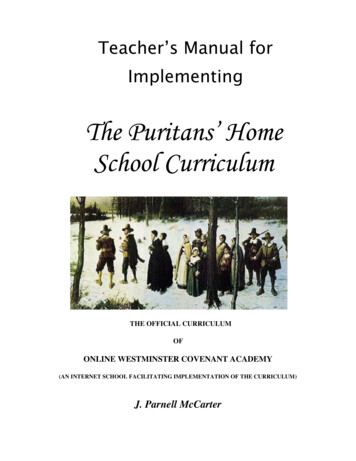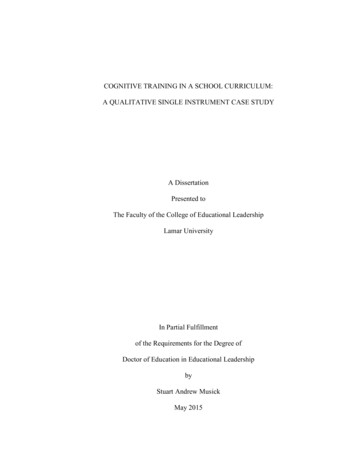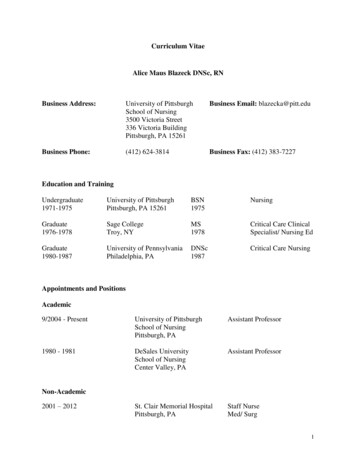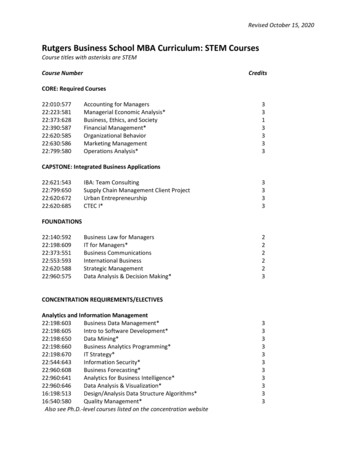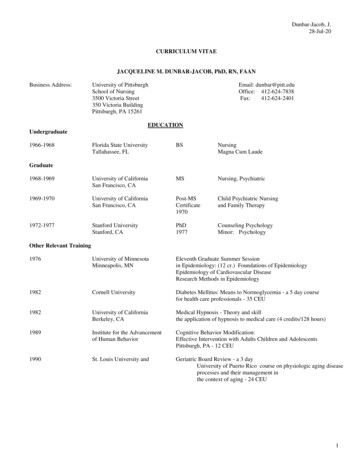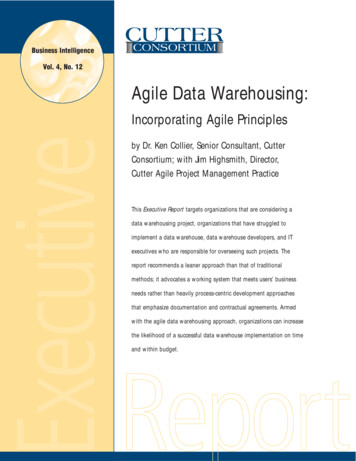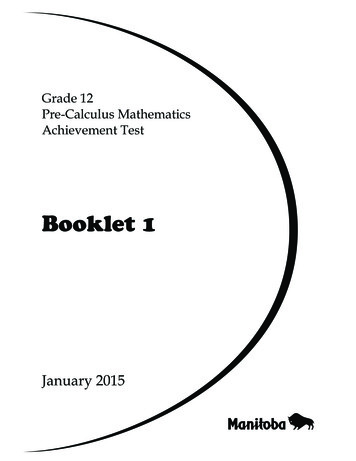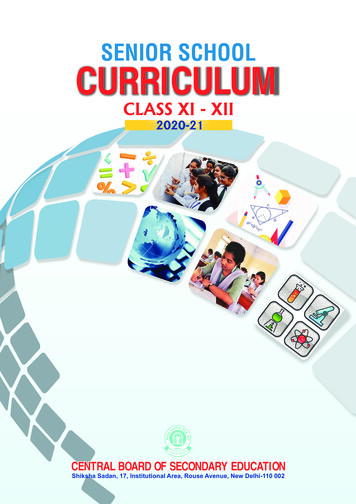
Transcription
SENIOR SCHOOLCURRICULUMCLASS XI - XII2020-21CENTRAL BOARD OF SECONDARY EDUCATIONShiksha Sadan, 17, Institutional Area, Rouse Avenue, New Delhi-110 002
1.PRINCIPLES OF THE CBSE CURRICULUMThe curriculum refers to the lessons and academic content to be taught toa learner in the school. In empirical terms, it may be regarded as the sumtotal of a planned set of educational experiences provided to a learner bya school. It encompasses general objectives of learning, courses of study,subject-wise instructional objectives and content, pedagogical practicesand assessment guidelines. The curriculum provided by CBSE is based onNational Curriculum Framework-2005 and seeks to provide opportunitiesfor students to achieve excellence in learning.1.1Salient Features of the CBSE Senior Secondary School CurriculumThe Curriculum prescribed by CBSE strives to:1.21.provide ample scope fordevelopment of students;physical,intellectualandsocial2.enlist general and specific teaching and assessment objectives;3.uphold Constitutional values such as Socialism, Secularism,Democracy, Republican Character, Justice, Liberty, Equality,Fraternity, Human Dignity of Individual and the Unity and integrityof the Nation by encouraging values-based learning activities;4.nurture Life-Skills by prescribing curricular and co-curricularactivities to help improve self-esteem, empathy towards differentcultures etc.;5.integrate innovations in pedagogy and assessment to keep pacewith the global trends in various disciplines;6.promote inclusive education by providing maximum possible equalopportunities to all students;7.integrate environmental education in various disciplines;8.equally emphasize Co-scholastic areas of General StudiesHealth and Physical Education.9.Promote Art integrating learning.andObjectives of the CurriculumThe Curriculum aims to:1.achieve desired national level of competencies in cognitive, affectiveand psychomotor domains;2.facilitate acquisition of 21st Century Skills and enhance self andsocial awareness through thematic or multidisciplinary approach;3.promote Cooperative Learning, Collaborative Learning, Self directedlearning etc. to facilitate realization of learning outcomes;4.promote Authentic Assessments based on real world tasks involvingmeaningful application of knowledge and skills;5.promote Life Skills , inculcate values , foster cultural learning andinternational understanding in an interdependent society;1
1.36.acquire the ability to utilize technology and information for thebetterment of humankind;7.strengthen knowledge and attitude related to livelihood skills andpromote lifelong learning;8.develop the ability to appreciate art and showcase talents;9.promote physical fitness, health and well-being Curriculum Areas at Senior Secondary LevelFor the purpose of fostering competences in learners, the curriculumencompasses seven major learning areas, which are: Languages, Humanities,Mathematics, Sciences, Skill Subjects, General Studies and Health and PhysicalEducation. These areas are broadly divided into Scholastic and Co-scholasticareas as detailed below:LanguagesScholastic AreasAcademic ElectivesSkill ElectivesGeneral StudiesHealth & Physical Education*Work ExperienceCo-scholastic Areas*Work experience is subsumed in Health and Physical Education1.3.1 Scholastic Areas:The curriculum envisages individualized personal learning acumen andseeks to explore the potential of students in acquiring substantialknowledge and skills through academic rigors. With greater academicorientation and research skills in core academic areas, students wouldevolve as discerning young adults with a sense of real self-esteem havingtrue values and principles. The scholastic areas are as follows:(i)Languages include Hindi, English and other 30 languages. Thecurricula in languages focus on listening, speaking, reading andwriting skills and to develop effective communicative proficiency.Learners use language to comprehend, acquire and communicateideas.(ii)Subjects like Geography, History, Economics, Home Science,Sociology, Fine Arts, Political Science, Fashion Studies, and relatedsubjects promote the learning of history and culture, geographicalenvironment, global institutions, constitutional values and norms,politics, economy, interpersonal and societal interactions, civicresponsibilities and the interplay of the above-mentioned learning.Learners appreciate and value every human's right to feel respectedand safe, and, in this regard, also understand their FundamentalRights and Duties and behave responsibly. Learners learn to betolerant and empathetic towards others through the study of thesesubjects.2
(iii) Subjects like Biology, Chemistry, Physics, Computer Science,Informatics Practices help in making students perceptive aboutmatter and energy, nature, the environment, technologybreakthrough in science. The focus is on knowledge and skills todevelop a scientific attitude and to use and apply such knowledgefor improving the quality of life. This learning can be used toanalyze and evaluate existing scenarios and propose innovativesolutions to situations. Learners understand and appreciate thephysical, biological and technological world and acquire theknowledge and develop attitude, skills and values to make rationaldecisions in relation to it.(iv) Mathematics includes acquiring the concepts related to numbers,operations, computation, measurement, geometry, probability andstatistics, the skill to calculate and organize and the ability to applythis knowledge and acquired skills in their daily life. It also includesunderstanding of the principles of reasoning and problem solving.Learners identify, integrate and apply numerical and spatialconcepts and techniques. They have clarity of concepts and are ableto connect them to the real world. Learners rationalize and reasonabout pre-defined arrangements, norms and relationships in order tocomprehend, decode, validate and develop relevant patterns.(v)Subjects like Business Studies, Accountancy, Entrepreneurship,Economics and related subjects help in gaining understanding aboutcore business disciplines. They understand the concept like, theexchange of items of value or products between persons orcompanies and the meaning / relevance/ Significance of any suchexchange of money for a product, service, or information.(vi) Subjects like Dance, Drama, Music, Heritage Crafts, Fine Arts,Sculpture and related subjects aim to help learners cultivate aninterest and appreciation for arts and encourage them toenthusiastically participate in related activities, thus, promotingabilities such as imagination, creativity, value arts, and the culturalheritage.(vii) Skill Electives help in development of professional competencies,which are analytical, applied and outcome based. Undergoing skillstraining in schools can help students learn about a tradeprogressively to create a product and also to become a problemsolver in real life. At present many Skill electives are beingoffered by the Board in the fields of Hospitality and Tourism,emerging technology like Artificial Intelligence, GeospatialTechnology, Finance, Business, Retail & Insurance etc. Studentscan also choose subject from diverse areas such as Fashion Design,Agriculture, Banking, Mass-Media Healthcare and many more.1.3.2 Co- Scholastic Areas:Co-curricular activities aim at development and using knowledge and skillsin different fields to groom the overall personality and character of3
students. It includes Health and Physical Education including WorkEducation and SEWA, various Creative Arts like Painting, Crafts, Danceand Music, and social activities. Instead of co-curricular activities, theterm co- scholastic activities is used as both cognitive and non-cognitivedevelopment can take place by exposing the child to the lesson onscholastic subjects and non-scholastic subjects. General Studies, Healthand Physical Education (Work Education has been subsumed) , Yoga,traditional games, indigenous sports, NCC, Scouts and Guides, Martial Artsetc. are integral part of the curriculum and would be in the routine of theschools for the holistic development of children as per the specific detailsgiven below:Health and Physical Education focuses on holistic development, bothmental and physical, understanding the importance of physical fitness,health, well-being and the factors that contribute to them. Focus of thisarea is on helping learners develop a positive attitude and commitment tolifelong, healthy active living and the capacity to live satisfying,productive lives with the help of health management, indigenous sports,yoga, NCC, self-defense, fitness and lifestyle choices.These learning areas are to be integrated with each other in terms ofknowledge, skills (life and livelihood), comprehension, values andattitudes. Learners should get opportunities to think laterally, critically,identify opportunity, challenge their potential and be open to challenges.Learners value and engage in practices that promote physical, cognitive,emotional and social development and wellbeing. This enables learners toconnect different areas of knowledge, application and values with theirown lives and the world around them. The holistic nature of humanlearning and knowledge should be brought forth throughout.General Studies: The purpose of orienting students to General Studies isto develop in them an appreciation for the holistic nature of knowledge.In contemporary times, familiarity with General Studies is indispensablebecause at the senior school stage there is an element of specializationdue to which the students do not get exposed to some vitaldisciplines/areas of study that are not covered in their specialized field.The whole course of General Studies is, therefore, focused on properdevelopment of the ‘affective domain’ by exposing the students to varieddomains of study.The documents with details of Health and Physical Education and GeneralStudies are available on www.cbseacademic.nic.in2.IMPLEMENTATION OF CURRICULUM2.1School Curriculum CommitteeThe Board mandates that all schools must setup a School CurriculumCommittee with teachers representing each areas. The School CurriculumCommittee would define activities for pedagogical practices, evolve aplan of assessment and mechanism of feedback and reflection and ensureits implementation. The committee would also ensure that the textbooks/4
reference materials are age appropriate, incorporate inclusive principles,are gender sensitive, have valid content and do not contain any materialwhich may hurt the sentiments of any community. The committee willthen send the list of books to the Principal to take action as per para2.4.7 (b) of the Affiliation Byelaws, 2018.The committee would alsoensure that the reference materials reflect conformity with theunderlying principles of the Constitution of India and are compliant withNCF-2005.Issues of gender, social, cultural and regional disparities mustbe taken care of in the curriculum transaction.2.2Pedagogical Leadership:All Principals have a crucial role to play in the evolution of the teachinglearning ecosystem as the Head and pedagogical leader of their schools. Inthe role of school pedagogical leader, the Principal is expected toundertake the following:a)Lead, Guide and Support the teaching and learning processes in theschool by focusing on classroom specific requirements fortransacting the curriculum, so that both teachers and studentsperform at their optimal best.b)Direct the entire focus of all school activities towards the students’learning and acquiring of necessary competencies. Every activitytaken up by the school, therefore, should be mapped for theacademic competencies, and for life skills, values, etc., beingacquired by the students.c)Prepare Annual Pedagogical Plan of the school by designing anddeveloping annual plan for the school by giving equal importance toscholastic and co-scholastic areas.d)Promote innovative pedagogy, with special focus on integrating art,sports and ICT (Information and Communication Technology) witheducation, and use active and experiential learning methods in theclassrooms.e)Ensure joyful learning at all levels through use of such innovativepedagogy.f)Develop school specific resources for teaching and learning, in theform of lesson plans, e-content, use of mathematics and sciencekits developed by NCERT, etc.g)Ensure proper in-house training of teachers in the school to enablethem to unleash their own unique capabilities and creativity intheir classrooms.h)To be up to date with all new ideas and tools, etc. being used ineducation at the global level and constantly innovate the pedagogyof the school.i)To make efforts to learn from the best practices of other schools,by arranging for discussions with Principals of such schools, orthrough observation visits of teachers to other schools.5
As a pedagogical leader, the principal must prepare Annual PedagogicalPlan. The Board has not laid down the structure or format of the annualpedagogical plan as the Board respects academic autonomy of everyschool and expects each school to prepare its own unique and innovativeannual plan. This plan must be an implementable one with timelines thatshould include administrative inputs and detailed pedagogical aspects.2.3Pedagogical Practices by TeachersThe pedagogical practices should be learner centric. It is expected of ateacher to ensure an atmosphere for students to feel free to askquestions. They would promote active learning among students with afocus on reflections, connecting with the world around them, creatingand constructing knowledge. The role of a teacher should be that of afacilitator who would encourage collaborative learning and developmentof multiple skills through the generous use of resources via diverseapproaches for transacting the curriculum.Teachers should follow inclusive principles and not label children as ‘slowlearners’ or ‘bright students’, or ‘problem children’. They
Education and SEWA, various Creative Arts like Painting, Crafts, Dance and Music, and social activities. Instead of co-curricular activities, the term co- scholastic activities is used as both cognitive and non-cognitive development can take place by exposing the child to the lesson on scholastic subjects and non-scholastic subjects. General Studies, Health and Physical Education (Work .

